TeleEpoch CDM2070 CDMA1X handset User Manual CDM2070PM UserMan
TeleEpoch Limited CDMA1X handset CDM2070PM UserMan
user manual rev

1
CDM2070PM User Guide
Content
1. For your safety ..................................................................................... 2
2.Phone Overview ..................................................................................... 2
2.1 Keypad ............................................................................................. 3
2.2 Main screen icons ................................................................................... 4
3.Details of your phone ................................................................................ 4
4.The Battery ......................................................................................... 5
5. Keypad overview ..................................................................................... 5
6. Operating your phone ................................................................................. 6
6.1 Messages ......................................................................................... 6
6.2 Call History ........................................................................................ 9
6.3 Contacts ......................................................................................... 10
6.4 Multimedia ....................................................................................... 10
6.5 Camera .......................................................................................... 11
6.6 Info Portal ........................................................................................ 11
6.7 Browser .......................................................................................... 11
6.8 Tools & Games ................................................................................... 12
6.9 Profiles .......................................................................................... 13
6.10 Settings ......................................................................................... 14
6.11 Bluetooth ....................................................................................... 15
6.12 Email, IM & Facebook ............................................................................ 15
7. Safety and Warranty ............................................................................... 16
7.1 SAFETY INFORMATION FOR WIRELESS HANDHELD PHONES ....................................... 16
READ THIS INFORMATION BEFORE USING YOUR HANDHELDPORTABLE CELLULAR TELEPHONE
EXPOSURE TO RADIO FREQUENCY SIGNALS ........................................................... 16
7.2 SAFETY INFORMATION FOR FCC ................................................................. 18
7.3 FDA CONSUMER UPDATE ........................................................................ 19
7.4 AVOID POTENTIAL HEARING LOSS ............................................................... 22
7.5 FCC/IC COMPLIANCE INFORMATION .............................................................. 23
7.6 12 MONTH LIMITED WARRANTY .................................................................. 23
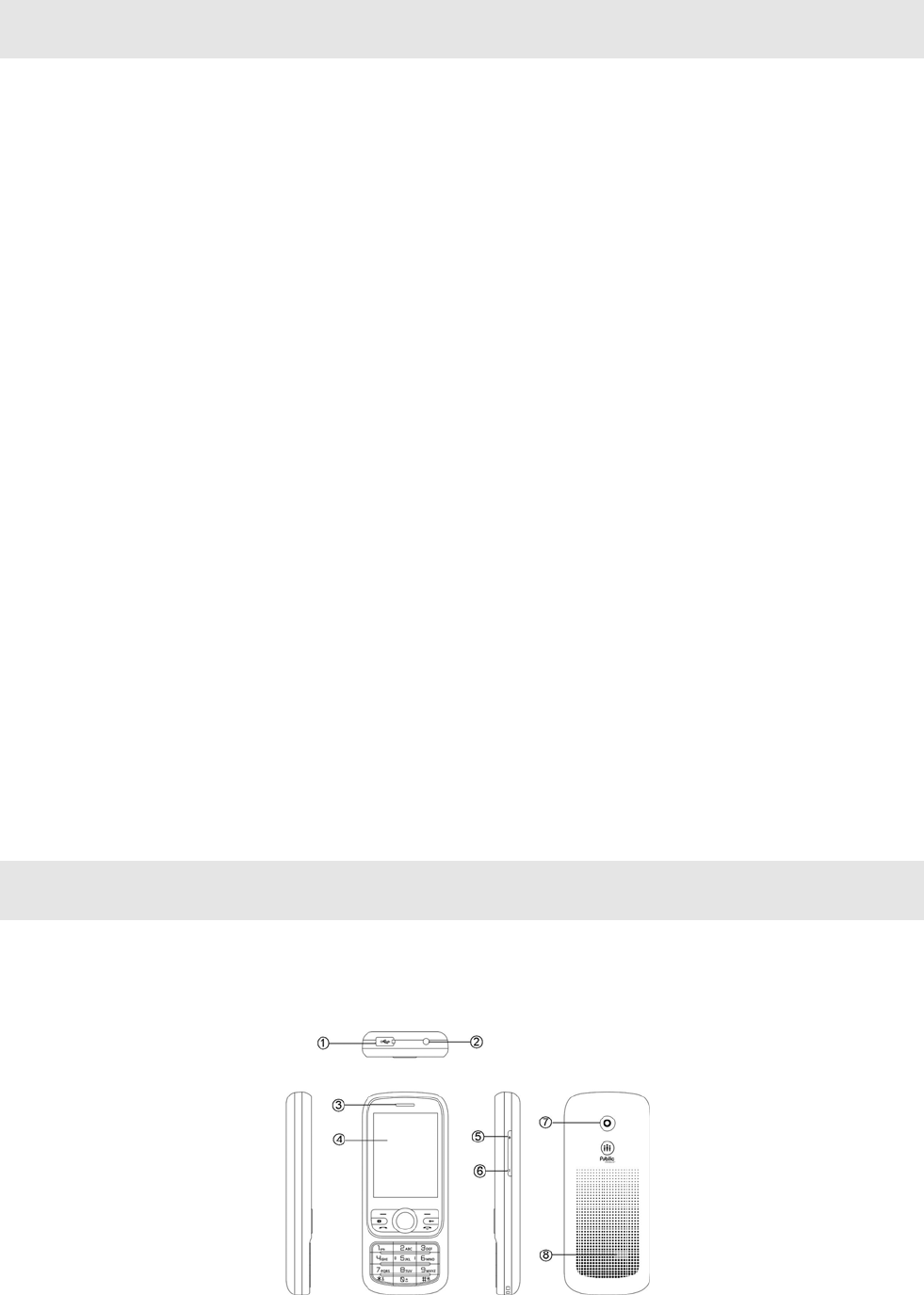
2
1. For your safety
Please read these guidelines before using your wireless phone. Failure to comply with them may be dangerous or illegal.
Road Safety at All Times
Do not use a hand-held device while driving; park the vehicle first.
Switching Off When Refueling
Do not use the phone at a gas station or near fuels or chemicals.
Switching Off in an Aircraft
Turn your phone off or put it in Airplane Mode while in an Aircraft, wireless phones can cause interference.
Switching Off in Hospitals
Switch your phone off near medical equipment. Follow any regulations or rules in force.
Interference
All wireless phones may be subject to interference, which could affect their performance.
Special Regulations
Please follow any special regulations in effect in any area and always switch your phone off whenever it is forbidden to use it, or when it may cause
interference or danger (in a hospital, for example.)
Emergency Call
Ensure the phone is switched on and in an area where there is wireless coverage. Input the emergency number and press the dial key. Give all the
necessary information as accurately as possible. Do not end the call until given permission to do so.
Liquid Resistance
Your phone is not liquid resistant. Keep it dry.
Accessories and Batteries
Use only approved accessories and batteries. Use of any unauthorized accessories could damage your phone and may be dangerous.
Important: For optimal use of the battery, fully charge the battery before you use the phone for the first time.
Important: Using a non-supported battery may cause damage to your phone.
Please dispose of used batteries appropriately. Do not throw them in the garbage. You may return it to the store from where you purchased the
phone.
2.Phone Overview
To guarantee your phone is always in its best condition, read this manual carefully and keep it for future reference.
Note: The pictures and icons presented in this manual are meant for illustrative purposes only and may not accurately reflect the actual pictures and
icons found on the phone.
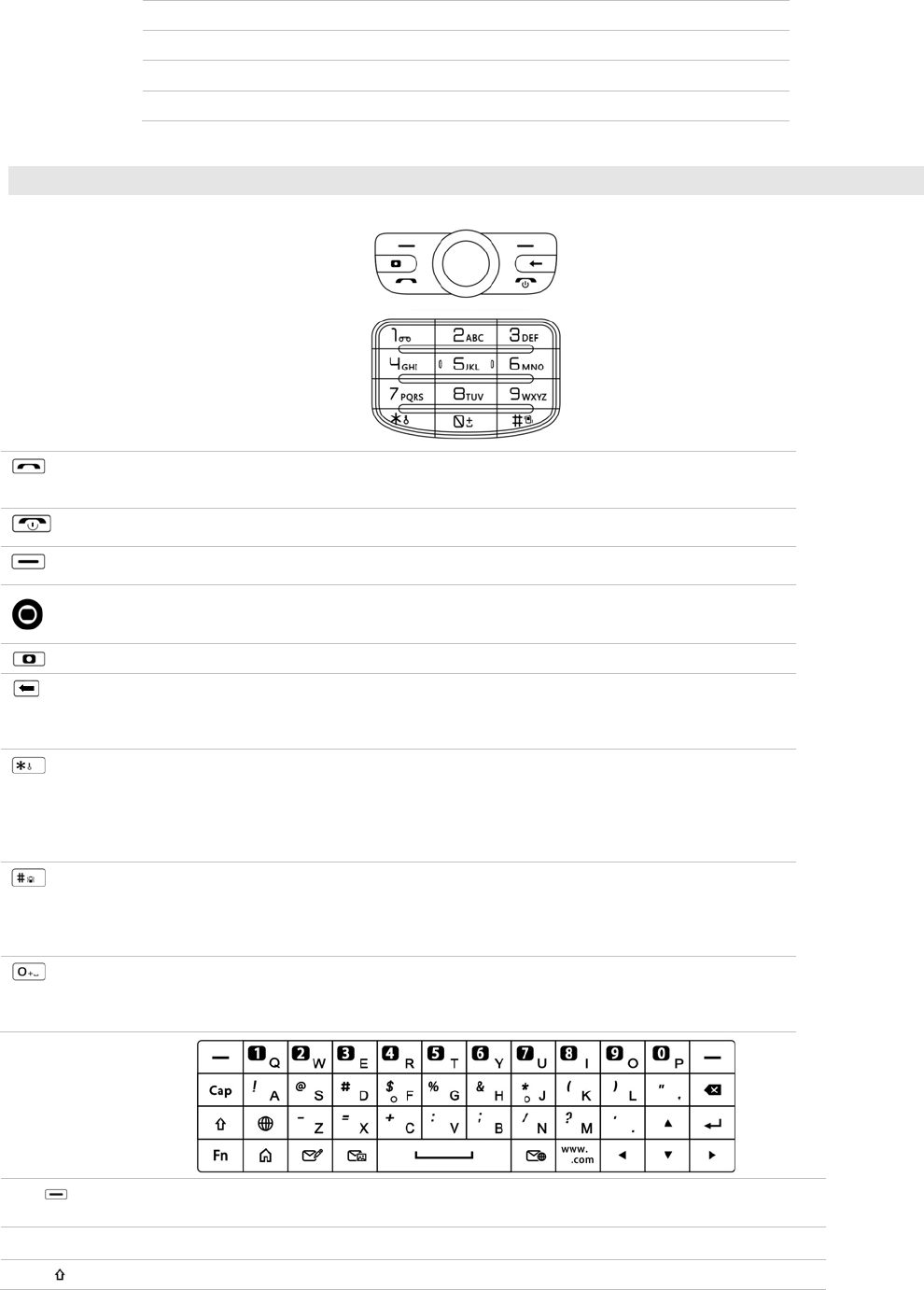
3
1Micro‐USB2EarphoneJack
3Receiver4Screen
5SideKey→Volumeup 6SideKey→Volumedown
7Camera 8Speaker
2.1 Keypad
Pick up
Send a call
Access call memory (Redial) (short key press)
End/Power Key: Press and hold this key for a few seconds to turn the phone on/off. During a call, press
this key to end the call and return to the main menu.
Left Soft key
Right Soft key
Navigation Key
Confirm an option (press the middle of the key)
Access main menu (short key press)
Camera Key
From idle screen
- Shortcut key press:, open Voice Command.
In other mode:
- Back Key
From idle screen
- Shortcut key press: *
- Press the middle of the Navigation Key then the * key: Locks the phone
- Press the Left Softkey then the * key:Unlock the phone
In Edit mode:
- Shortcut key press: Access the Symbols table
From idle screen
- Shortcut key press: #
- Long key press: Activate/deactivate Vibrating Mode
In Edit mode:
-Shortcut key press: Changes input methods
From idle screen
-Shortcut key press: 0
In Edit mode:
-Space or zero
Left Soft key
Right Soft key
Cap Switch between uppercase and lowercase modes
Switch to up character
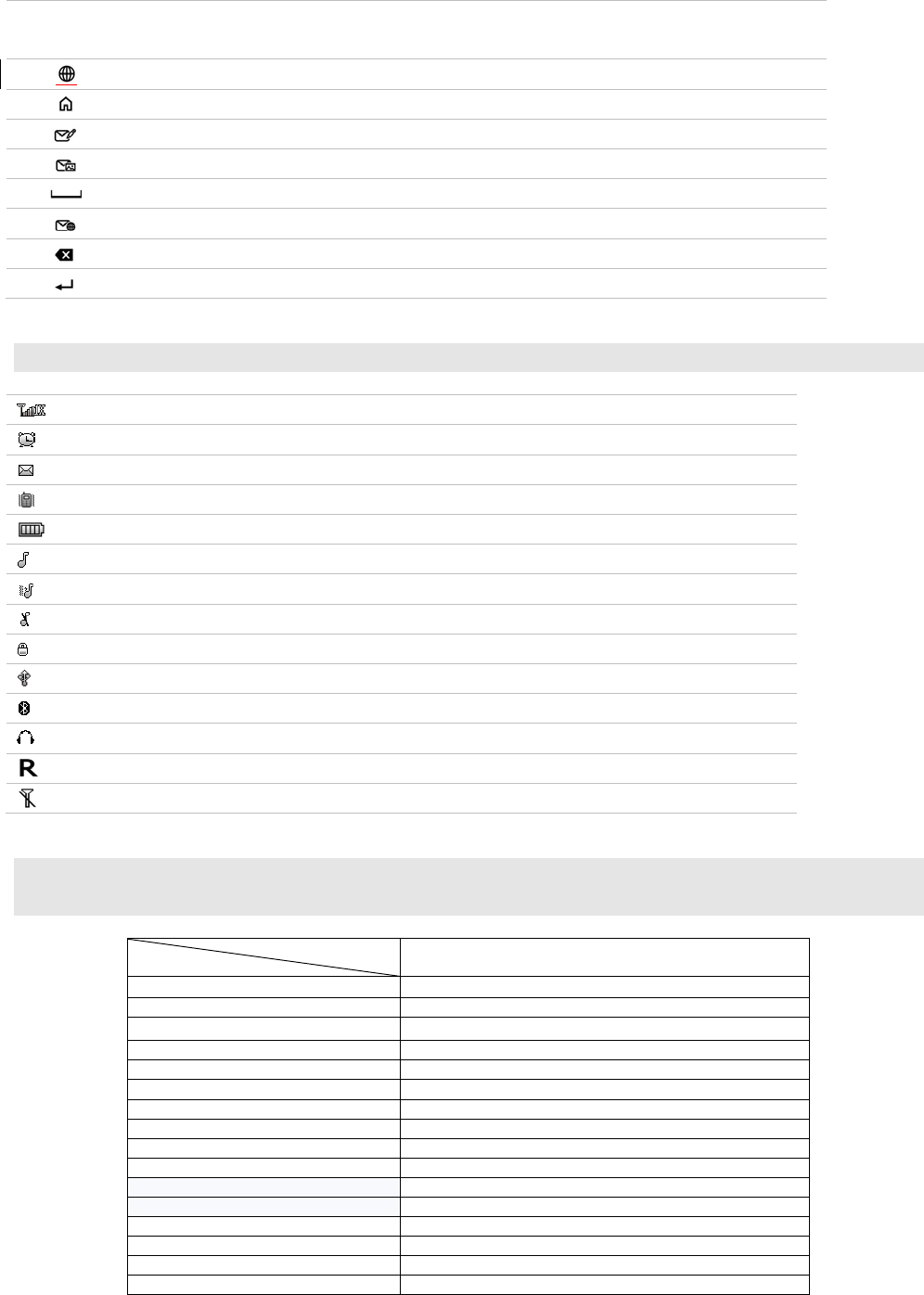
4
Fn Press Fn plus Space Key to switch input method; press Fn plus number to type number; press Fn plus www. to
type www.
Enter Browser
To the main menu
Write SMS
Write Picture Message
Space Key
Write Email
Back Key
Return Key
2.2 Main screen icons
Signalstrengthreceivedbytheantenna
Alarmclock
Thereis(are)unreadmessage(s)
Vibrateicon
Batterylevelindicator(Thisiconindicatesfullbattery)
Ringicon
Vibratefirstthenring
MuteIcon
Keypadlocked
USBconnected
BluetoothOn
Earphoneinserted
Roaming
Airplane Mode
3.Details of your phone
Phone mode
Specifications CDM2070PM
Size 119.8x 50.6 x 15.2mm
Weight (excluding battery) 120g
Screen display resolution 2.4” QVGA(320 x240)
Frequency Bands CDMA 800MHz/1900MHz,G-block
Bluetooth Included
Recording Included
MMS/ WAP Included
Contacts capacity 1,000 contacts
Message capacity 500 messages
Call history 20 records of missed, received and dialed calls
Preset ringtones 10 options
Message alert tone 10 options
Call time Included
Speed dial Included
MP3 Included
Camera 1.3MP
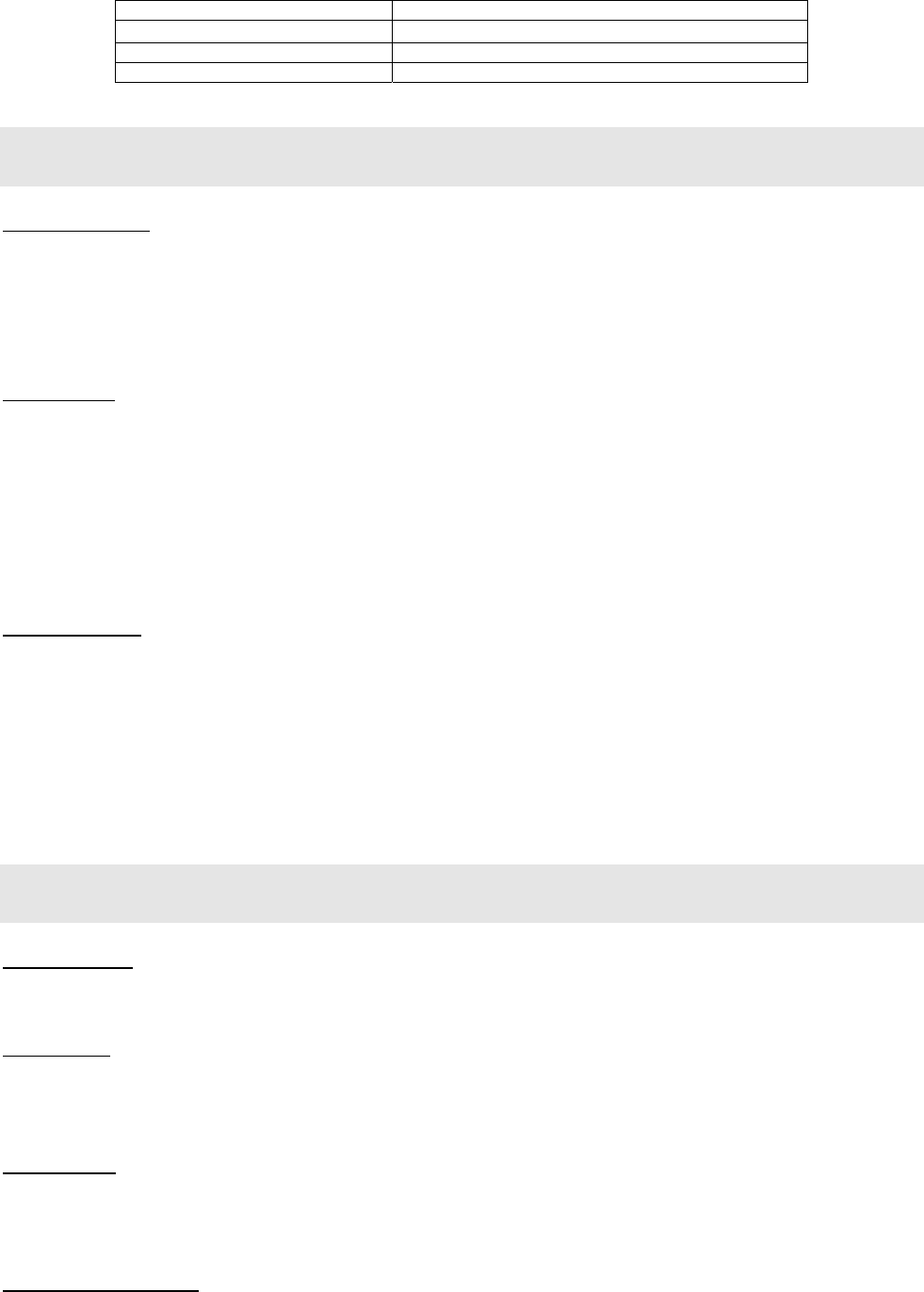
5
Date and time display Supported
Alarm clock/calculator Supported
Games Snake and Blackjack
Incoming call display Supported
4.The Battery
Installing your battery
Remove the back cover. At the bottom of the phone there’s a slot to loosen the cover. Once loosened, peel around the cover and remove it
completely. Remove the battery from its protective packaging and insert it in the back of the phone so that the contacts on the battery make contact
to the contacts on the phone.
Be sure the battery sits flush with the inside of the phone.
Battery charging
The phone uses a rechargeable battery. The battery should be charged fully before using it for the first time. Optimal battery
performance will occur after charging and discharging a few times.
For optimal battery performance let your battery run out completely once every month.
It is normal for the battery to heat up when charging. Your phone has automatic temperature adjustment protection.
When the battery is about to run out, the phone will notify you. When the battery runs out completely the phone turns off automatically.
Note: The actual usage time for the battery will vary under different operating modes and settings. The phone may turn off when the battery is low,
please charge when necessary.
Charging the battery
Connect the charger to a power outlet and then plug the charger into the micro USB port on the top of the phone.
When the phone is charging, the battery icon indicator bars will move from left to right.
You can charge the phone while the phone is powered on or off.
The battery icon indicator bars will stop automatically when the battery is fully charged. When the battery icon shows four green bars, you
can disconnect your charger..
Please use the original charger; the use of other chargers may damage your phone.
5. Keypad overview
Send and End keys
The Send key is used to make a phone call (after entering the numbers) or to view recent call history.
The End key is used to end a phone call or exit from the menu (when placing or receiving a call) and return to the standby menu.
Navigation keys
The up, down, left and right navigation keys are used to browse through a menu.
In standby mode, the up navigation key is the shortcut key for calendar; the down navigation key is the shortcut key to access the Info portal the left
navigation key is the shortcut key to access multimedia, and the right navigation key is the shortcut key to access messages.
Standard keypad
The number keys of 0-9 and the #/* keys are used to dial, enter passwords, enter letters and symbols.
■Note: The screen will turn off when it is in standby mode for a length of time that can be adjusted by the user. If the screen backlight turns off, press
any key to turn it back on.
Language and entry method

6
To change the language from French to English, access the main menu, and then select SettingsPhoneLanguage.
The phone’s entry methods include French, English, numbers and symbols. When typing a message use the “#” key to switch entry methods
(English, French, capital letters or lower case letters) and the “*” key to switch to the symbols.
Main Menu
Press the middle of the navigation keys the “OK key” in standby mode to enter the main menu.
The main menu includes 12 menu options. Each menu has several submenus. Various functions of the phone can be set, checked or changed
through the main menu.
Use the navigation keys in the main menu interface to navigate through the main menu options.
To select a function in the main menu scroll to the menu option you want to access and press the OK key.
Use the up/down navigation key to scroll through the submenus, use the left and Right Soft keys to navigate through the submenus
Press the End key to exit from the menu and return to the standby interface.
Personalizing the text message tone
From the main menu select Profiles, select your preferred mode (normal, loud, vibrate, silent), select personalize, select message alert tone
and scroll through the list to select your preferred tone.
Personalizing the Incoming call ring
From the main menu select Profiles, select your preferred mode (normal, loud, vibrate, silent), select personalize, select ringtone and scroll
through the list to select your preferred ringtone
6. Operating your phone
Power on
Press and hold the “On/Off” Power key for a few seconds to turn on the phone. The phone will automatically search for the network. Once registered
in the network, the signal strength will be displayed.
Power off
Press and hold the “On/Off” Power key for a few seconds to turn off the phone.
Note: If the battery is removed without powering down first, some information may be lost.
Making a phone call
In standby mode enter the numbers on the keypad and press the Send key to make a call.
Controlling the volume
You can press the up and down navigation keys to adjust the handset volume during a call, or press the up and down keys on the left side of the
phone to adjust the volume.
Answering a phone call
When a call comes in, press the Send key to answer the call, or press any key to answer (if the function of any key answer is set).
6.1 Messages
If the phone is turned off or outside of the coverage area, messages will be stored and sent to the phone once the phone is turned back on. When a
new message is received an icon will appear showing you have a new message. The message waiting icon will appear on the top of the phone.
Text Messaging
Receiving a text message
1. Select the messages icon
2, Select Text Messaging
3, Scroll to Inbox
7
4. Use the OK Key to view the message
Send a Text message
Note: Text messages cannot exceed 140 characters.
Creating a new text message
1. Select the Messages icon
2. Select Text Messaging
3. Select New Text Message
4. Type your message using the key pad.
5. Use the Left Soft key to select More
6. Select Sent to
7. Enter the phone number to send the message and then press send using the OK key
After or while entering the contents of a text message press Left Soft key more you can select the following options:
1. Send to: Enter the phone number to send the message to
2. Insert: Allows you to enter information from your contacts or template messages into the text
3. Text Entry: Select the entry method, options include numbers, capital letters and the ability to toggle between English and French
4. Save to Drafts
5. Cancel message: This returns you to the message list interface
Text Messaging Menu items
1. Inbox
The Inbox is used to read received messages. Press the up and down navigation keys in the Inbox to browse the message list. Press the Left
Soft key More when reading the messages in the Inbox to enter to the following menus:
1. Reply: Reply to the current read message
2. Reply with Content: Reply to the current read message with the content
3. Delete: Delete the current read message
4. Call: Places a call to the person who sent the text message
5. Forward: Forward the current message to other people
6. Lock: Lock the message so it cannot be deleted.
7. Delete Multiple: Delete multiple text messages
8. Clean up Message: Delete read or all messages in your inbox
9. New Text Message: Compose a new text message
2. Outbox
The Outbox is used to store messages sent unsuccessfully;
3. Sentbox
4. Draftbox
Select Save to Drafts when writing a new text message and the message will be saved in the Draftbox.
5. Template
Template stores 12 common phone messages, which can be added, edited or deleted to a message.
6. Conversation
The conversation function is used to view messages received and messages sent to a certain contact or number.
1. After entering the conversation function interface, use the up and down navigation keys to move the cursor and select a certain contact or
number, and then press the Left Soft key to select either Delete Conversation or Delete All Conversations.
2. Press the OK key in the Conversation function interface to view the chat logs of the selected contact or number; and then press the up
and down navigation keys to move the cursor and view the logs.
3. The Conversation logs include the following information: Receiver (Send to), date and time (Sent on), and status of the message.

8
7. Settings
1. Auto-delete: On/Off
2. Memory status: Displays the number of stored messages and the maximum capacity.
3. Signature: Set the signature information to add to all outgoing messages.
8. Delete
1. All: Delete all text messages and voice messages in the Inbox, Outbox, Sent Messages and Drafts.
2. Inbox: Delete all messages in the Inbox.
3. Outbox: Delete all messages in the Outbox.
4. Sentbox: Delete all messages in the Sentbox.
5. Draftbox: Delete all messages in the Draftbox.
6. Voice Mail: Delete all voice messages.
Picture Messaging
The phone supports the function of sending and receiving Picture Messaging (multimedia messages).
(Note: The receiver must have picture messaging on their phone in order to receive a Picture Message. After selecting Picture Messaging, use the
up and down navigation keys to move the cursor and select the following menus: Create Picture Massage, Inbox, Outbox, Drafts, Sent, Templates
and Settings.
Note:Themaximumsizeforapicturemessageis600kB.Youwillbenotifiedifyouhaveexceededthisamount
1.Create Picture Message
- After entering the interface of Create Picture Message, enter the receiving contact In the To field, input the phone number or
press the Left Soft key to open Contacts to access your contact list.
- Scroll down to the Slide field, press the Left Soft key Menu and scroll to Insert, Select using the Left Soft key and scroll to image
and insert the image you would like to send.
- In the next field beneath the Slide field, enter your message and select OK using the Left Soft key.
- Press the Left Soft key Menu to select Send.
A. Press the Left Soft key in the interface of New Multimedia Message to enter the following options: Send, Add, Insert, Erase, Preview, Preview
Time, Save to Drafts and Save to Templates. The Add option includes: Add New Pages, Add Themes, Carbon Copy and Blind Carbon Copy.
The Insert option includes: Insert Photos, Insert Audio Files, Insert Pictures, Insert Rings and Insert Others.
2.Inbox
The Inbox is used to view Picture Messages received. Options in the Inbox include: Open, Reply, Forward, Delete, Delete All and Lock/Unlock.
3.Outbox
The Outbox is used to store Picture Messages sent unsuccessfully. Options in the Outbox include: Resend, Delete, Delete All and Lock/Unlock.
4.Drafts
Select Drafts when creating a new Picture Message to save the Picture Message to Drafts. Options in Drafts include: Forward, Delete, Delete All
and Lock/Unlock.
5.Sent
Picture messages sent successfully can be saved to Sent Picture Messages. Options in Sent include: Resend, Forward, Delete, Delete All and
Lock/Unlock.
6.Templates
Select Templates when creating a new Picture Message you want to save as Template.
7.Settings
A. Profile: Support Public Mobile and the User-defined. The default profile is Public Mobile;
B. Send
Delivery Report: Set delivery report to on/off
Read Report: Set read report to on/off;

9
Save sent items: Store sent picture messages: Set save sent items to on/off§ Auto-deletion (Sent): Set auto-deletion to on/off
Retry times: Edit the number of times to resend (0-3 times)
C. Receive
Send Delivery Report: Set the send delivery report to on/off
Send Read Report: Set to Never, Always or Manual
Retrieval mode: Set to Auto, Manual or Reject
D. Edit:
Signature: Set signature on/off.
Slide timing: Set the switching time for previewing the picture message slides to 2 seconds, 5 seconds, 8 seconds or 10 seconds.
E. View mode: Set to Auto or Manual.
F. Memory status: Displays the space used, free space and number of picture messages.
G. Restore default: Restore the settings to the defaults yes/no.
H. Save Picture Messaging: Set to save the picture message to the microSD card or the phone memory.
I. Version: The picture messaging version number.
Voice mail
Select Voice Mail in the menu or press and hold the “1” key in the standby mode, the phone will automatically enter your Voice Mail service.
Email, IM & Facebook
(Need seven email add the content)
6.2 Call History
From the main menu select Call History
Missed Calls
If there are missed calls, you can view the detailed information in Missed Calls, including contact name, phone number, date and time.
Missed calls include the following two situations:
1. If the incoming call number is not stored in the contacts directory, press the Left Soft key after selecting the number to edit the missed call:
Delete: Delete the missed call record
Save to Contacts
Dial the number
Send Message: Allows you to send a Text or Picture Message to the missed calls number
2. If the incoming call number has been stored in the contacts directory, the name of the caller will be displayed.
Received Calls
The phone automatically saves information about the 20 most recently received calls. The functional operation and display mode is the same as
those of missed calls.
Dialed Calls
The phone automatically saves information about the 20 most recently dialed calls. The functional operation and display mode is the same as those
of missed calls.
Delete Log
1. Delete Missed Calls: Delete records of all missed calls.
2. Delete Received Calls: Delete records of all received calls.
3. Delete Dialed Calls: Delete records of all dialed calls.
4. Delete All: Delete all records of recent calls.
Call Time
1.Last Call Time

10
2.Total Dialed: Total of all dialed calls since the timer was last reset
3.Total Received: Total of all received calls since the timer was last reset
4.Total Call Time
5.Total Life Time
6.Reset All Time
6.3 Contacts
Adding a new contact
1. From the main menu select the Contacts icon
2. Scroll to and select Create New Contact
3. Enter the contact information using the Left Soft key to edit and the key pad to enter the letter or numbers
4. Save and store the contact’s information using the OK key
Placing a call using the contact directory
1. From the main menu select the Contacts icon
2. Select contact list
3. Select the contact you wish to call
4. Select the phone number
5. Press the Send key to call the contact
Contacts submenu options:
Contact List: Display all contacts. Allows you to edit contact information
Create New Contact: Create a new contact.
Group: Create up to 10 different groups. You may group your contacts into different groups.
Set Speed dial: Create shortcuts to reach phone numbers in the contacts list. The speed dial for number 1 is reserved for voice mail, numbers 2 to 9
can be set for your personal contacts.
Memory Info: Displays the number of contacts in your contacts directory.
6.4 Multimedia
Select the multimedia icon in the main menu to enter the multimedia menu
Audio Player
The audio player can play all audio files stored in the phone or the memory card. Supported music file formats include: MP3, MIDI, AMR, AAC, WAV
and QCP.
The music player interface icons are: Previous, Pause, Play, Stop and Next. You can move the cursor using the left and right Navigation Keys and
then press the OK key to perform an operation.
Press the Left Soft key to enter the following function menus:
1. Add To play list;
2. Listen via Bluetooth: Connect the phone with Bluetooth
3. Send: Send through Bluetooth, picture message and Email.
4. Set To: Send the music to the Phone Profiles.
5. Manager: Delete the selected music.
6. Select several options: Select several options of the song to add or delete.
7. File Attributes: View the audio file attributes.
8. Play Mode: Set on/off the Repeat Play and Shuffle Play.
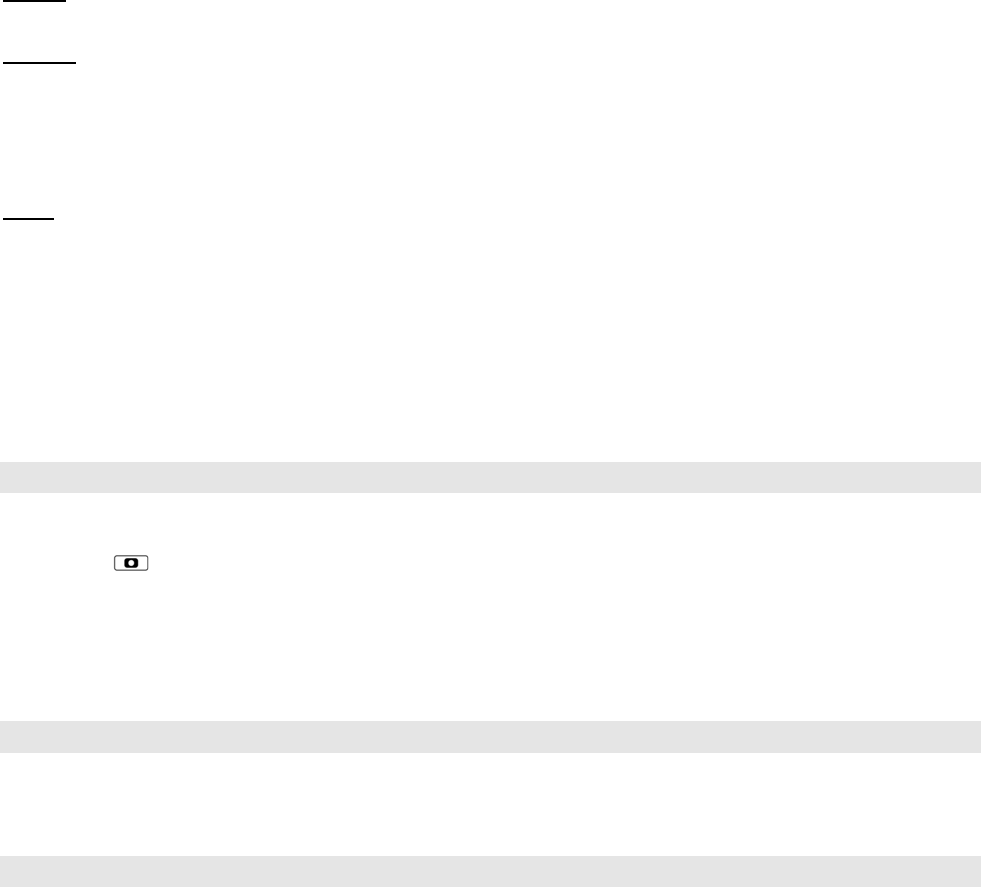
11
Note: When adding new music to the phone, select the “Update Playlist” function in the audio player option interface.
When using the audio player to play music, press the “+” and “-” keys on the left side of the phone to control the volume.
Camera
The camera is also accessible within this menu screen. Please refer to the section on camera for more details.
Recorder
This feature allows the recording of voice through the phone microphone. The files will be stored in the phone’s memory and the size of the file
depends upon the amount of memory available, Standard functions for this feature include: Record, Play, Pause, Stop, Rewind and Fast Forward.
It supports the recording function when answering and dialing a call.
Note: Please abide by the local laws and regulations when recording.
Gallery
The phone provides certain memory space. The function is used to properly manage the files stored in the phone or on the memory card:
1. Enter the Gallery
2. Select the file with the up and down navigation keys (select the files stored in the phone memory or the memory card) and press the OK key to
Open the file selected.
3. After entering the file, press the up and down navigation keys to select the folder; press the Left Soft key to enter the functions of Manage, Mark,
New Directory and Memory Status. The Manage function includes the functions to Copy To, Move To, Delete or Property.
6.5 Camera
The camera can be accessed by:
1. Pressing the “ ” key on the phones keypad.
2. Selecting the Camera icon in the main menu interface.
3. Selecting the Multimedia icon in the main menu interface and scrolling to Camera.
Note: Please abide by the local laws and regulations when using the camera.
6.6 Info Portal
Visit Public Mobile’s home page. For more details, please refer to the Browser section.
6.7 Browser
Enter the Browser function by selecting the Browser icon in the main menu. The Browser allows you to surf the internet using your phone.
1. Home Page: Default web page that will be visited every time the user opens the Browser.
2. Enter URL: Enter the URL for the website to be viewed.
3. Search: Select from the list of search engines to perform a search. Enter the text you would like to search and then highlight the search engine
you want to use to perform the search and select Go using the Left Soft key.
4. History: View the latest accessed web pages
5. Bookmarks: Multiple bookmarks can be created. After entering the option menu, the operations include: Open, Add bookmark, Delete bookmark,
Delete all bookmarks, Edit bookmark, Lock bookmark, New directory , Details and Reset.
6. Push Box: Store information on messages to notify the user about Browser site messages
7. Saved Web Pages: Select to save a page for reviewing later
8. Advanced Options: The advanced options are used to configure certain internet parameters and information
9. About: Displays the version number of the browser and the platform.
10. Exit Browser: Exit the browser and return to the menu interface.

12
6.8 Tools & Games
Tools
Alarm
You may set up to 6 alarms
Select the Alarm function under the Tools option. Use the navigation key to select one of the alarms and press the Left Soft key to edit the alarm
setting.
1. State: Turn the Alarm on/off using the right and left navigation keys
2. Alarm time: Set the ring time for the alarm clock, use the key pad to change the numbers and the ok key to switch between AM/PM
3. Repeat alarm: Use the right and left navigation keys to set the alarm to Once, Everyday or Custom
4. Alarm ring: Select from various different alarm ring tones
5. Snooze time-out: Use the Ok Key to select your snooze time
Notes
Select Create Note after entering the Notes interface. The upper textbox is used to enter the note contents. The Type at the bottom of the screen
is used to select the type of note (None, Personal, Business, Meeting, Call, Travel, Vacation), use the right and left navigation keys to move between
various types.
1. In Create Note, use the Left Soft key Options and select the OK Key to create your note. Enter the note text using the letters on the keypad. Use
the # key to switch between capital and lower case letters and English/French. Use the * key for symbols. Press the OK key, Tab to switch
between the note content and Type.
2. The options under Note include: Create Note, This note, (submenus under this note include Edit, Delete, Unmark and Send via Bluetooth), All
notes (submenus under All notes include: (Delete all, Unmark all, Send via Bluetooth), Mark Mode and Memory status.
Calculator
The calculator can perform four standard operations, adding, subtracting, multiplying, and dividing.
Use the numeric keys 0-9 to input a value. Use the “*” key to input a decimal point. Use the “#” key to enter a positive or negative number.
The calculator is operated as follows:
1. Press the number keys to enter a value
2. Select an operation key using the up/down/right/left navigation keys
3. Press the number keys to enter the second number
4. Select the “=” key using the Ok key. The results will be displayed on the screen
Note: To perform multiple mathematical operations, you must press the equal “=” key after each step of the calculation operation.
Stopwatch
The function includes two modes: Common Mode and Loop Mode
TheCommonModeisasimplestopwatch.
1.Press“Begin”tostarttiming.
2.PressOKKeytostop.
3.Pressagaintocontinuetiming.Ifthereisatimenoted,presstheOKkeytoclear.
TheLoopModeissothatadditionaltimesegmentscanbeadded,startedandstoppedtorecordvariousactivitieswithintheevent.The“add”
buttonaddsanotherloopwhilerecordingthepreviousloop’stime.
World Time
To view the time in different locations around the world, use the left and right navigation keys to move the cursor and select the time zone.
Calendar
You can view the current date or scroll the calendar to view the calendar of other months.
Press the Left Soft key, Options in the interface of the Calendar to enter the following functions:
1. Week View: View the calendar in the view type week
2. Day View: View the calendar in the view type day

13
3. Make a note: Create a new calendar entry (Meeting, Call, Birthday, Memo, Reminder)
4. Go to date: View the calendar of the designated month/day/year
5. Go to today: View the calendar of the current day
6. Calendar tone: Select the ring for the calendar notification
7. Go to do list: View the list of calendar entries
8. Delete all notes: Delete all calendar entries
Schedule
You may schedule an event into the calendar, with date, time, and an alarm to notify you of that event.
1. Add: After entering the function of Schedule, press the Left Soft key to add the calendar notification
2. Select calendar notification types: Meeting, Call, Birthday, Memo, and Reminder
3. Calendar settings: After selecting the type, press the OK key to enter the details. The details can include: Subject, Location, Start/End Date,
Start/End Time, Repeat, Alarm Type, Name, Phone Number, Date of Birth etc. depending on the type of calendar entry.
Bluetooth
To pair a new Bluetooth device with your phone:
1.Device Search
When Device Search is enabled, all nearby discoverable Bluetooth devices will be found. Select the Bluetooth device you are looking for and pair it
with your phone.
After detecting a Bluetooth hands free device, a Bluetooth password must be entered to perform the pairing. (Bluetooth password are set by other
Bluetooth devices).
When pairing is finished, you can connect your phone to the Bluetooth device.
2.Discoverable on 60 seconds: When this function is enabled, Bluetooth devices can be found within 60s.
3.Found Devices: The Bluetooth devices found will be displayed.
4.Manage: You can carry out pairing between Bluetooth devices, delete or browse a file, or view the Bluetooth on/off status and parameter
configuration of this phone, reset the Bluetooth name, etc.
Unit Converter
You can select from the following options: Area, Length, Mass, Temperature, Velocity and Volume.
Ez Tip Calc
Quickly calculate the tip and the cost of the bill if you are splitting it.
Downloads
You can browse, purchase, and download apps online. Apps will be charged on your regular phone bill.
From the Home screen, press Menu >Tools >Mobile Shop
- Select you favor application from Catalog and download it.
- Search: you may also search for applications by keywords. Select search from the main menu of the App download.
Note: Download only support Brew format.
Games
This mobile phone provides two games: Snake and BlackJack.
1. Select “Games” from the Tools & Games menu icon
2. Press the “Up/Down Navigation Key” to select a game.
3. Press “OK” or “Left Soft key” to enter the game selected.
Note: You can view “Game Help” and “Top Score” in the Snake game, you can also turn on/off the game sound using “Game Audio”.
6.9 Profiles
The Profiles setting is used to customize the phone’s alerts and ringtones. To select and personalize the Profile settings, select the Profiles icon from

14
the main menu. There are five predefined profile settings that can be customized: Normal, Loud, Vibrate, Silent, and Airplane Mode.
Note: In Airplane Mode, please consult airline staff about the use of Airplane Mode in flight. Turn off your phone whenever instructed to do so by
airline staff. Airplane Mode turns off your phone’s calling features in location where wireless phone use is prohibited. You cannot make or receive
calls in Airplane Mode, but you can use your phone’s other non-calling features.
After entering Profiles, move the cursor with the up and down navigation keys to select the different modes; press the OK key or the Left Softkey to
enter the mode selected.
Activate: Activates the mode selected and sets it as the current mode.
Personalize: You are able to customize the settings for the various Profile modes.
1. Incoming call alert: Alert method for incoming calls
2. Voice Volume: Set the volume of the speaker.
3. Ringtone: Allows you to select the incoming call ringtone. The phone provides 10 types of incoming call rings and the audio files in the file
management system can also be selected as the incoming call ringtone
4. Ring volume: Set the ring volume for incoming calls
5. Vibrate alert: Select whether or not to enable vibration
6. Message alert tone: Select the message alert tone. The phone provides 10 types of message tones and the audio files in the file
management system can also be selected as the message alert tone.
7. Roaming Ringtone: Allows you to select the roaming ringtone. The phone provides 10 types of roaming rings and the audio files in the file
management system can also be selected as the message alert ringtone
8. Keypad tone: Set the keypad volume.
9. Auto Answer: Set the auto answer time
10. Speakerphone: Select whether or not to enable the speaker.
6.10 Settings
Select the Settings menu icon from the main menu
Phone
Language: Select English or French
Greeting: Switch between Enable and Disable, press the Left Softkey or the OK key to edit the current greeting and it will be displayed when
turning on the phone.
Clock Format: Set between 12 hour (with a.m. and p.m.) or 24 hours
Date Format: Three types can be selected: day/month/year; month/day/year; year/month/day;
Roaming: Automatic or Home Only
Data Roaming: Enable or Disable
Voice Readout: Select from Keypad Digits, Contact List Entries, and Recent Call Entries.
USB Disk Mode: Enables the transfer of data between a PC and the installed microSD card on the phone using a data cable.
Display
Wallpaper: Select a picture for the background image on the phone
LCD Backlight: Select from 10s/20s/30s/Always On Note: the longer the backlight is on the faster the battery will drain.
Brightness: You can select the brightness level of the LCD backlight by pressing the left and right navigation keys
Main Menu: You can set the main menu as Icon or List mode
Themes: Three themes can be selected.
Call
Answer Options: Select Flip Open, Any Key and Send Only to answer a call
Call Duration Reminder: Set the reminder to sound during calls at 45 seconds, 50 seconds, 55 seconds or off.

15
Call Connect Notification: If this feature is Enabled a notification will be sent when connecting a call
DTMF Tones: Select Long or Short;
TTY Mode: Supports TTY Off, TTY Full, TTY VCO and TTY HCO
Auto Redial: Select between Disable and Enable
Security
To make changes in the Security menu, you must correctly input the phone password, the initial password is 0000.
Phone Lock: If the phone lock is Enabled, it will prompt you to enter the correct password to use the phone when powering the phone on
Keypad Lock: The keypad lock can be set to be enabled at 5 seconds, 30 seconds, 60 seconds or 5 minutes or turned off. Press the Left
Soft key and then press the “*” key to unlock the keypad. Even when locked you may answer an incoming call
Call History Lock: If enabled the phone will require the password to be entered to access Call History;
Phonebook Lock: If enabled the phone will required the password to be entered to access Contacts
Message Lock: If enabled the phone will require the password to be entered to access messages.
Restrictions: After entering the correct password of 0000, this function can be used for restricting incoming and outgoing calls, incoming and
outgoing text messages and incoming and outgoing picture messages and IP connections. It supports three options: Allow All, Block All and
Contacts Only.
Change Password: After entering the current password, enter the new password, enter the same new password twice and then press the
Left Soft key or the Ok key to confirm. During the process, you can press the Right Soft key, Back, to cancel and return to the previous menu.
You can change the Phone Password, Call History Password, Phonebook Password, Message Password and Restriction Password
Restore Factory Settings: This function is used for restoring the phone to its default factory settings.
Phone Info
Base Phone Information: Displays the software and hardware information about the phone.
Icon Glossary: Displays all icons for the phone.
6.11 Bluetooth
To pair a new Bluetooth device with your phone:
Device Search
When Device Search is enabled, all nearby discoverable Bluetooth devices will be found. Select the Bluetooth device you are looking for and pair it
with your phone.
After detecting a Bluetooth hands free device, a Bluetooth password must be entered to perform the pairing. (Bluetooth password are set by other
Bluetooth devices).
When pairing is finished, you can connect your phone to the Bluetooth device.
Discoverable on 60 seconds: When this function is enabled, Bluetooth devices can be found within 60s.
Found Devices: The Bluetooth devices found will be displayed.
Manage: You can carry out pairing between Bluetooth devices, delete or browse a file, or view the Bluetooth on/off status and parameter
configuration of this phone, reset the Bluetooth name, etc.
6.12 Email, IM & Facebook
With the Mobile Email application, you can connect your phone to your personal or workplace e-mail accounts.
A. Select the Email icon to launch the application
B. Follow the onscreen instructions to set up your account and use the Mobile Email
Note: For detailed information, please contact your service provider.
( Need to add by seven email)

16
7. Safety and Warranty
This chapter addresses the safety guidelines and precautions to follow when operating your phone. Before operating your phone, please
be aware of all the safety details. This chapter contains the terms and conditions of services and the warranty for your phone. Please
review them thoroughly.
7.1 SAFETY INFORMATION FOR WIRELESS HANDHELD PHONES
READ THIS INFORMATION BEFORE USING YOUR HANDHELDPORTABLE CELLULAR TELEPHONE EXPOSURE TO RADIO FREQUENCY
SIGNALS
Your wireless handheld portable telephone is a low power radio transmitter and receiver. When it is ON, it receives and also sends out
radio frequency (RF) signals.
In August 1996, the Federal Communications Commissions (FCC) adopted RF exposure guidelines with safety levels for handheld
wireless phones. Those guidelines are consistent with the safety standards previously set by both U.S. and international standards bodies:
ANSI C95.1 (1992) *
NCRP Report 86 (1986) *
ICNIRP (1996) *
Those standards were based on comprehensive and periodic evaluations of the relevant scientific literature. For example, over 120 scientists,
engineers, and physicians from universities, government health agencies, and industry reviewed the available body of research to develop the ANSI
Standard (C951).
The design of your phone complies with the FCC guidelines (and those standards).
1*: American National Standards Institute.
2*: National Council on Radiation protection and measurements.
3*: International Commission on Nonionizing Radiation Protection.
ANTENNA SAFETY
Use only the supplied or an approved replacement antenna. Unauthorized antennas, modifications, or attachments could impair call quality,
damage the phone, or result in violation of FCC regulations. Please contact your local dealer for replacement antenna. Do not use the phone with a
damaged antenna. If a damaged antenna comes into contact with the skin, a minor burn may result. Please contact your local dealer for
replacement antenna.
DRIVING SAFETY
Talking on the phone while driving is extremely dangerous and is illegal in some states. Remember, safety comes first. Check the laws and
regulations on the use of phones in the areas where you drive. Always obey them. Also, if using your phone while driving, please:
Give full attention to driving. Driving safely is your first responsibility.
Use hands-free operation, if available.
Pull off the road and park before making or answering a call, if driving conditions so require.
If you must use the phone while driving, please use one-touch, speed dialing, and auto answer
modes. An airbag inflates with great force. DO NOT place objects, including both installed or portable wireless equipment, in the area over the
17
airbag or in the air bag deployment area. If in-vehicle wireless equipment is improperly installed and the air bag inflates, serious injury could result.
WARNING: Failure to follow these instructions may lead to serious personal injury and possible property damage.
ELECTRONIC DEVICES
Your wireless handheld portable telephone is a low power radio transmitter and receiver. When it is
ON, it receives and also sends out radio frequency (RF) signals. Most modern electronic equipment is shielded from RF energy. However, certain
electronic equipment may not be shielded against the RF signals from your wireless phone. Therefore, use of your phone must be restricted in
certain situations.
PACEMAKERS
The Health Industry Manufacturers Association recommends that a minimum separation of six (6”) inches be maintained between a handheld
wireless phone and a pacemaker to avoid potential interference with the pacemaker. These recommendations are consistent with the independent
research by and recommendations of Wireless Technology Research. Persons with pacemakers:
ALWAYS keep the phone more than six inches from your pacemaker when the phone is turned on.
Do not carry the phone in a breast pocket.
Use the ear opposite the pacemaker to minimize the potential for interference.
If you have any reason to suspect that interference is taking place, turn your phone OFF immediately.
HEARING AIDS
Some digital wireless phones may interfere with some hearing aids. In the event of such interference, you may want to consult your service
provider (or call the customer service line to discuss alternatives).
OTHER MEDICAL DEVICES
If you use any other personal medical device, consult the manufacturer of your device to determine if they are adequately shielded from external RF
energy. Your physician may be able to assist you in obtaining this information.
Turn your phone OFF in healthcare facilities when any regulations posted in these areas instruct you to do so. Hospitals or healthcare facilities
may be using equipment that could be sensitive to external RF energy.
VEHICLES
RF signals may affect improperly installed or inadequately shielded electronic systems in motor vehicles. Check with the manufacturer or its
representative regarding your vehicle. You should also consult the manufacturer of any equipment that has been added to your vehicle.
POSTED FACILITIES
Turn your phone OFF where posted notices so require.
OTHER SAFETY GUIDELINES
AIRCRAFT
FCC regulations prohibit using your phone while in the air. Turn your phone OFF before boarding an aircraft. Always request and obtain prior
consent and approval of an authorized airline representative before using your phone aboard an aircraft. Always follow the instructions of the
airline representative whenever using your phone aboard an aircraft, to prevent any possible interference with airborne electronic equipment.
BLASTING AREAS
To avoid interfering with blasting operations, turn your phone OFF when in a “blasting area” or in areas posted: “Turn off two-way radio.” Obey all
signs and instructions.
POTENTIALLY EXPLOSIVE ATMOSPHERES
Turn your phone OFF when in any area with a potentially explosive atmosphere and obey all signs and instructions. Sparks in such areas could
cause an explosion or fire resulting in bodily injury or even death.
Areas with a potentially explosive atmosphere are often, but not always, clearly marked. They include fueling areas such as gas stations; below
deck on boats; fuel or chemical transfer or storage facilities; vehicles using liquefied petroleum gas (such as propane or butane); areas where the air
contains chemicals or particles, such as grain, dust, or metal powders; and any other area where you would normally be advised to turn off your

18
vehicle’s engine.
PRECAUTIONS
Your Handheld Portable Telephone is a high quality piece of equipment. Before operating, read all instructions and cautionary markings on (1)
AC/DC Travel Adaptor (2) Battery and (3) Product Using Battery.
Failure to follow the directions below could result in serious bodily injury and/or property damage due to battery liquid leakage, fire or rupture.
DO NOT use this equipment in an extreme environment where high temperature or high humidity exists.
DO NOT abuse the equipment. Avoid striking, shaking or shocking. When not using, lay down the unit to avoid possible damage due to
instability.
DO NOT expose this equipment to rain or spilled beverages.
DO NOT use unauthorized accessories.
DO NOT disassemble the phone or its accessories. If service or repair is required, return unit to an authorized PCD cellular service center. If
unit is disassembled, the risk of electric shock or fire may result.
DO NOT short-circuit the battery terminals with metal items etc.
7.2 SAFETY INFORMATION FOR FCC
This mobile phone meets the government’s requirements for exposure to radio waves.
This phone is designed and manufactured not to exceed the emission limits for exposure to radio frequency (RF) energy set by the Federal
Communications Commission of the U.S. Government.
The exposure standard for wireless mobile phones employs a unit of measurement known as the Specific Absorption Rate, or SAR. The SAR limit
set by the FCC is 1.6W/kg. *Tests for SAR are conducted using standard operating positions accepted by the FCC with the phone transmitting at
its highest certified power level in all tested frequency bands. Although the SAR is determined at the highest certified power level, the actual SAR
level of the phone while operating can be well below the maximum value. This is because the phone is designed to operate at multiple power
levels so as to use only the power required to reach the network. In general, the closer you are to a wireless base station, the lower the power
output.
The highest SAR value for the model phone as reported to the FCC when tested for use at the ear is 0.959 W/kg and when worn on the body, as
described in this user guide, is 1.130 W/kg (Body-worn measurements differ among phone models, depending upon available accessories and FCC
requirements.)
While there may be differences between the SAR levels of various phones and at various positions, they all meet the government requirement.
The FCC has granted an Equipment Authorization for this model phone with all reported SAR levels evaluated as in compliance with the FCC RF
exposure guidelines. SAR information on this model phone is on file with the FCC and can be found under the Display Grant section of
www.fcc.gov/oet/ea/fccid after searching on FCC ID: U46-CDM2070.
For body worn operation, this phone has been tested and meets the FCC RF exposure guidelines for use with an accessory that contains no metal
and the positions the handset a minimum of 1.5 cm from the body. Use of other accessories may not ensure compliance with FCC RF exposure
guidelines. If you do not use a body-worn accessory and are not holding the phone at the ear, position the handset a minimum of 1.5 cm from your
body when the phone is switched on.
IMPORTANT NOTE:
IC Radiation Exposure Statement

19
This EUT is compliance with SAR for general population/uncontrolled exposure limits in IC RSS-102 and had been tested in accordance with the
measurement methods and procedures specified in IEEE 1528 and IEC 62209. This equipment should be installed and operated with minimum
distance 1.5cm between the radiator & your body.
7.3 FDA CONSUMER UPDATE
U.S. FOOD AND DRUG ADMINISTRATION CENTER FOR DEVICES AND RADIOLOGICAL HEALTH CONSUMER UPDATE ON WIRELESS
PHONES
1. Do wireless phones pose a health hazard?
The available scientific evidence does not show that any health problems are associated with using wireless phones. There is no proof, however,
that wireless phones are absolutely safe. Wireless phones emit low levels of radiofrequency energy (RF) in the microwave range while being used.
They also emit very low levels of RF when in the stand-by mode. Whereas high levels of RF can produce health effects (by heating tissue),
exposure to low level RF that does not produce heating effects causes no known adverse health effects. Many studies of low level RF exposures
have not found any biological effects. Some studies have suggested that some biological effects may occur, but such findings have not been
confirmed by additional research. In some cases, other researchers have had difficulty in reproducing those studies, or in determining the reasons
for inconsistent results.
2. What is FDA’s role concerning the safety of wireless phones?
Under the law, FDA does not review the safety of radiation-emitting consumer products such as wireless phones before they can be sold, as it does
with new drugs or medical devices. However, the agency has authority to take action if wireless phones are shown to emit radiofrequency energy
(RF) at a level that is hazardous to the user. In such a case, FDA could require the manufacturers of wireless phones to notify users of the health
hazard and to repair, replace or recall the phones so that the hazard no longer exists. Although the existing scientific data do not justify FDA
regulatory actions, FDA has urged the wireless phone industry to take a number of steps, including the following:
• Support needed research into possible biological effects of RF of the type emitted by wireless phones;
• Design wireless phones in a way that minimizes any RF exposure to the user that is not necessary
for device function; and
• Cooperate in providing users of wireless phones with the best possible information on possible effects of wireless phone use on human
health.
FDA belongs to an interagency working group of the federal agencies that have responsibility for different aspects of RF safety to ensure
coordinated efforts at the federal level. The following agencies belong to this working group:
National Institute for Occupational Safety and Health
Environmental Protection Agency
Federal Communications Commission
Occupational Safety and Health Administration
National Telecommunications and Information Administration
The National Institutes of Health participates in some inter-agency working group activities, as well. FDA shares regulatory responsibilities for
wireless phones with the Federal Communications Commission (FCC). All phones that are sold in the United States must comply with FCC safety
guidelines that limit RF exposure. FCC relies on FDA and other health agencies for safety questions about wireless phones. FCC also regulates
the base stations that the wireless phone networks rely upon. While these base stations operate at higher power than do the wireless phones
themselves, the RF exposures that people get from these base stations are typically thousands of times lower than those they can get from
wireless phones. Base stations are thus not the subject of the safety questions discussed in this document.
3. What kinds of phones are the subject of this update?
The term “wireless phone” refers here to hand-held wireless phones with built-in antennas, often called “cell,”“mobile,” or “PCS” phones. These
types of wireless phones can expose the user to measurable radiofrequency energy (RF) because of the short distance between the phone and the
20
user’s head. These RF exposures are limited by Federal Communications Commission safety guidelines that were developed with the advice of
FDA and other federal health and safety agencies. When the phone is located at greater distances from the user, the exposure to RF is drastically
lower because a person’s RF exposure decreases rapidly with increasing distance from the source. The so-called “cordless phones,” which have a
base unit connected to the telephone wiring in a house, typically operate at far lower power levels, and thus produce RF exposures far below the
FCC safety limits.
4. What are the results of the research done already?
The research done thus far has produced conflicting results, and many studies have suffered from flaws in their research methods. Animal
experiments investigating the effects of radiofrequency energy (RF) exposures characteristic of wireless phones have yielded conflicting results
that often cannot be repeated in other laboratories. A few animal studies, however, have suggested that low levels of RF could accelerate the
development of cancer in laboratory animals.
However, many of the studies that showed increased tumor development used animals that had been genetically engineered or treated with
cancer-causing chemicals so as to be predisposed to develop cancer in the absence of RF exposure. Other studies exposed the animals to RF for
up to 22 hours per day. These conditions are not similar to the conditions under which people use wireless phones, so we don’t know with certainty
what the results of such studies mean for human health. Three large epidemiology studies have been published since December 2000. Between
them, the studies investigated any possible association between the use of wireless phones and primary brain cancer, glioma, meningioma, or
acoustic neu-roma, tumors of the brain or salivary gland, leukemia, or other cancers. None of the studies demonstrated the existence of any harmful
health effects from wireless phone RF exposures. However, none of the studies can answer questions about long-term exposures, since the
average period of phone use in these studies was around three years.
5. What research is needed to decide whether RF exposure from wireless phones poses a health risk?
A combination of laboratory studies and epidemiological studies of people actually using wireless phones would provide some of the data that are
needed. Lifetime animal exposure studies could be completed in a few years. However, very large numbers of animals would be needed to provide
reliable proof of a cancer promoting effect if one exists. Epidemiological studies can provide data that is directly applicable to human populations,
but 10 or more years’ follow-up may be needed to provide answers about some health effects, such as cancer. This is because the interval between
the time of exposure to a cancer-causing agent and the time tumors develop - if they do -may be many, many years. The interpretation of
epidemiological studies is hampered by difficulties in measuring actual RF exposure during day-to-day use of wireless phones. Many factors affect
this measurement, such as the angle at which the phone is held, or which model of phone is used.
6. What is FDA doing to find out more about the possible health effects of wireless phone RF?
FDA is working with the U.S. National Toxicology Program and with groups of investigators around the world to ensure that high priority animal
studies are conducted to address important questions about the effects of exposure to radiofrequency energy (RF). FDA has been a leading
participant in the World Health Organization International Electromagnetic Fields (EMF) Project since its inception in 1996. An influential result of
this work has been the development of a detailed agenda of research needs that has driven the establishment of new research programs around the
world. The Project has also helped develop a series of public information documents on EMF issues. FDA and the Cellular Telecommunications &
Internet Association (CTIA) have a formal Cooperative Research and Development Agreement (CRADA) to do research on wireless phone safety.
FDA provides the scientific oversight, obtaining input from experts in government, industry, and academic organizations. CTIA-funded research is
conducted through contracts to independent investigators. The initial research will include both laboratory studies and studies of wireless phone
users. The CRADA will also include a broad assessment of additional research needs in the context of the latest research developments around the
world.
7. How can I find out how much radiofrequency energy exposure I can get by using my wireless phone?
All phones sold in the United States must comply with Federal Communications Commission (FCC) guidelines that limit radiofrequency energy (RF)
exposures. FCC established these guidelines in
consultation with FDA and the other federal health and safety agencies. The FCC limit for RF exposure from wireless telephones is set at a
Specific Absorption Rate (SAR) of 1.6 watts per kilogram (1.6 W/ kg). The FCC limit is consistent with the safety standards developed by the
Institute of Electrical and Electronic Engineering (IEEE) and the National Council on Radiation Protection and Measurement. The exposure limit

21
takes into consideration the body’s ability to remove heat from the tissues that absorb energy from the wireless phone and is set well below levels
known to have effects. Manufacturers of wireless phones must report the RF exposure level for each model of phone to the FCC. The FCC website
(http://www.fcc.gov/oet/rfsafety) gives directions for locating the FCC identification number on your phone so you can find your phone’s RF
exposure level in the online listing.
8. What has FDA done to measure the radiofrequency energy coming from wireless phones ?
The Institute of Electrical and Electronic Engineers (IEEE) is developing a technical standard for measuring the radiofrequency energy (RF)
exposure from wireless phones and other wireless handsets with the participation and leadership of FDA scientists and engineers. The standard,
“Recommended Practice for Determining the Spatial-Peak Specific Absorption Rate (SAR) in the Human Body Due to Wireless Communications
Devices: Experimental Techniques,” sets forth the first consistent test methodology for measuring the rate at which RF is deposited in the heads of
wireless phone users. The test method uses a tissue-simulating model of the human head. Standardized SAR test methodology is expected to
greatly improve the consistency of measurements made at different laboratories on the same phone. SAR is the measurement of the amount of
energy absorbed in tissue, either by the whole body or a small part of the body. It is measured in watts/ kg (or milliwatts/g) of matter. This
measurement is used to determine whether a wireless phone complies with safety guidelines.
9. What steps can I take to reduce my exposure to radiofrequency energy from my wireless phone?
If there is a risk from these products—and at this point we do not know that there is—it is probably very small. But if you are concerned about
avoiding even potential risks, you can take a few simple steps to minimize your exposure to radiofrequency energy (RF). Since time is a key factor in
how much exposure a person receives, reducing the amount of time spent using a wireless phone will reduce RF exposure.
• If you must conduct extended conversations by wireless phone every day, you could place more distance between your body and the source of
the RF, since the exposure level drops off dramatically with distance.
For example, you could use a headset and carry the wireless phone away from your body or use a wireless phone connected to a remote antenna.
Again, the scientific data do not demonstrate that wireless phones are harmful. But if you are concerned about the RF exposure from these
products, you can use measures like those described above to reduce your RF exposure from wireless phone use.
10. What about children using wireless phones?
The scientific evidence does not show a danger to users of wireless phones, including children and teenagers. If you want to take steps to lower
exposure to radiofrequency energy (RF), the measures described above would apply to children and teenagers using wireless phones. Reducing
the time of wireless phone use and increasing the distance between the user and the RF source will reduce RF exposure. Some groups sponsored
by other national governments have advised that children be discouraged from using wireless phones at all. For example, the government in the
United Kingdom distributed leaflets containing such a recommendation in December 2000. They noted that no evidence exists that using a wireless
phone causes brain tumors or other ill effects. Their recommendation to limit wireless phone use by children was strictly precautionary; it was not
based on scientific evidence that any health hazard exists.
11. What about wireless phone interference with medical equipment?
Radiofrequency energy (RF) from wireless phones can interact with some electronic devices. For this reason, FDA helped develop a detailed test
method to measure electromagnetic interference (EMI) of implanted cardiac pacemakers and defibrillators from wireless telephones. This test
method is now part of a standard sponsored by the Association for the Advancement of Medical instrumentation (AAMI). The final draft, a joint
effort by FDA, medical device manufacturers, and many other groups, was completed in late 2000. This standard will allow manufacturers to
ensure that cardiac pacemakers and defibrillators are safe from wireless phone EMI. FDA has tested hearing aids for interference from handheld
wireless phones and helped develop a voluntary standard sponsored by the Institute of Electrical and Electronic Engineers (IEEE). This standard
specifies test methods and performance requirements for hearing aids and wireless phones so that that no interference occurs when a person
uses a “compatible” phone and a “compatible” hearing aid at the same time. This standard was approved by the IEEE in 2000. FDA continues to
monitor the use of wireless phones for possible interactions with other medical devices. Should harmful interference be found to occur, FDA will
conduct testing to assess the interference and work to resolve the problem.
12. Where can I find additional information?

22
For additional information, please refer to the following resources:
FDA web page on wireless phones (http://www.fda.gov/cellphones)
Federal Communications Commission (FCC) RF Safety Program (http://www.fcc.gov/oet/rfsafety)
International Commission on Non-Ionizing Radiation Protection (http://www.icnirp.de)
World Health Organization (WHO) International EMF Project (http://www.who.int/emf )
Health Protection Agency (UK) (http://www.hpa.org.uk/radiation/)
7.4 AVOID POTENTIAL HEARING LOSS
Prolonged exposure to loud sounds (including music) is the most common cause of preventable hearing loss. Some scientific research suggests
that using portable audio devices, such as portable music players and cellular telephones, at high volume settings for long durations may lead to
permanent noise-induced hearing loss. This includes the use of headphones (including headsets, earbuds and Bluetooth® or other wireless
devices). Exposure to very loud sound has also been associated in some studies with tinnitus (a ringing in the ear), hypersensitivity to sound and
distorted hearing. Individual susceptibility to noise-induced hearing loss and other potential hearing problems varies.
The amount of sound produced by a portable audio device varies depending on the nature of the sound, the device, the device settings and the
headphones. You should follow some commonsense recommendations when using any portable audio device:
Set the volume in a quiet environment and select the lowest volume at which you can hear adequately.
When using headphones, turn the volume down if you cannot hear the people speaking near you or if the person sitting next to you can hear
what you are listening to.
Do not turn the volume up to block out noisy surroundings. If you choose to listen to your portable device in a noisy environment, use
noise-cancelling headphones to block out background environmental noise.
Limit the amount of time you listen. As the volume increases, less time is required before your hearing could be affected.
Avoid using headphones after exposure to extremely loud noises, such as rock concerts, that might cause temporary hearing loss. Temporary
hearing loss might cause unsafe volumes to sound normal.
Do not listen at any volume that causes you discomfort. If you experience ringing in your ears, hear muffled speech or experience any
temporary hearing difficulty after listening to your portable audio device, discontinue use and consult your doctor.
YOU CAN OBTAIN ADDITIONAL INFORMATION ON THIS SUBJECT FROM THE FOLLOWING SOURCES:
American Academy of Audiology
11730 Plaza American Drive, Suite 300
Reston, VA 20190
Voice: 800-AAA-2336
Email: info@audiology.org
Internet: www.audiology.org
National Institute on Deafness and Other Communication Disorders National Institutes of Health
31 Center Drive, MSC 2320
Bethesda, MD USA 20892-2320
Voice: (301) 496-7243
Email: nidcdinfo@nidcd.nih.gov
Internet: http://www.nidcd.nih.gov/health/hearing
National Institute for Occupational Safety and Health
Hubert H. Humphrey Bldg.

23
200 Independence Ave., SW
Washington, DC 20201
Voice: 1-800-CDC-INFO (1-800-232-4636)
Internet: http://www.cdc.gov/niosh/topics/noise/default.html
7.5 FCC/IC COMPLIANCE INFORMATION
This device complies with Part 15 of FCC Rules. Operation is subject to the following two conditions:
(1) This device may not cause harmful interference, and
(2) This device must accept any interference received. Including interference that may cause undesired operation.
INFORMATION TO THE USER
This equipment has been tested and found to comply with the limits for a Class B digital device pursuant to Part 15 of the FCC Rules. These limits
are designed to provide reasonable protection against harmful Interference in a residential installation This equipment generates, uses, and can
radiate radio frequency energy and, if Not installed and used in accordance with the instructions, may cause harmful Interference to radio
communications. However, there is no guarantee that interference will not occur in a particular Installation. If this equipment does cause harmful
interference to radio or television reception, which can be determined by turning the equipment off and on, the user is encouraged to try to correct
the interference by one or more of the following measures:
Reorient or relocate the receiving antenna. Increase the separation between the equipment and receiver.
Connect the equipment into an outlet of a circuit different from that to which the receiver is connected.
Consult the dealer or an experienced radio/TV technician for assistance.
CAUTION: Changes or modification not expressly approved by the party responsible for Compliance could void the user’s authority to operate the
equipment. Connecting of peripherals requires the use of grounded shielded signal cables.
IC Notice
This device complies with Industry Canada license-exempt RSS standard(s). Operation is subject to the following two conditions:
(1) this device may not cause interference, and
(2) this device must accept any interference, including interference that may cause undesired operation of the device.
This Class B digital apparatus complies with Canadian ICES-003.
IC: 9412A-CDM2070PM
7.6 12 MONTH LIMITED WARRANTY
Personal Communications Devices, LLC (the "Company") warrants to the original retail purchaser of this cellular handset or wireless device
(Product), that should this Product or any part thereof during normal consumer usage and conditions, be proven defective in material or
workmanship that results in the Product's failure within the first twelve (12) month period from the date of purchase (proof of purchase required),
such defect(s) will be repaired or replaced (with new or rebuilt parts) at the Company’s option, without charge for parts or labor directly related to
the defect(s).
The antenna, keypad, display, rechargeable battery and battery charger, if included with the Product, are similarly warranted for twelve (12) months
from the date of purchase.
This Warranty extends only to consumers who purchase the product in the United States or Canada and it is not transferable or assignable.
This Warranty does not apply to:
(a) Product subjected to abnormal use or conditions, accident, mishandling, neglect, unauthorized alteration, misuse, improper installation or repair
or improper storage;
24
(b) Product whose mechanical serial number or electronic serial number has been removed, altered or defaced;
(c) Damage from exposure to moisture, humidity, excessive temperatures or extreme environmental conditions;
(d) Damage resulting from connection to, or use of any accessory or other product not approved or authorized by the Company;
(e) Defects in appearance, cosmetic, decorative or structural items such as framing and non-operative parts;
(f) Product damaged from external causes such as fire, flooding, dirt, sand, weather conditions, battery leakage, blown fuse, theft or improper
usage of any electrical source;
(g) Product subjected to unauthorized modifications to the software of the Product or to the Product itself;
(h) Product subjected to the unauthorized opening or repair of the Product;
(i) Product subjected to hacking, password-mining, jail breaking, the unlocking of the boot loader using the fast boot program or the tampering with
or short-circuiting of the battery; or
(j) Product that has been modified to alter functionality or capability of the Product without the written permission of the Company.
The Company disclaims liability for removal or reinstallation of the Product, for geographic coverage, for inadequate signal reception by the antenna
or for communications range or operation of the cellular system as a whole.
When sending your wireless device to the Company for repair or service, please note that any personal data or software stored on the Product may
be inadvertently erased or altered. Therefore, we strongly recommend you make a back up copy of all data and software contained on your Product
before submitting it for repair or service. This includes all contact lists, downloads (i.e. third-party software applications, ringtones, games and
graphics) and any other data added to your Product. In addition, if your Product utilizes a SIM or Multimedia card, please remove the card before
submitting the Product and store for later use when your Product is returned. The Company is not responsible for and does not guarantee
restoration of any third-party software, personal information or memory data contained in, stored on, or integrated with any other wireless device,
whether under warranty or not, returned to the Company for repair or service.
To obtain repairs or replacement within the terms of this Warranty, the Product should be delivered with proof of Warranty coverage (e.g. dated bill
of sale), the consumer’s return address, daytime phone number and/or fax number and complete description of the problem, transportation prepaid,
to the Company at the address shown below or to the place of purchase for repair or replacement processing. In addition, for reference to an
authorized Warranty station in your area, you may telephone in the United States (800) 229-1235, and in Canada (800) 465-9672 (in Ontario call
416-695-3060).
THE EXTENT OF THE COMPANY’S LIABILITY UNDER THIS WARRANTY IS LIMITED TO THE REPAIR OR REPLACEMENT PROVIDED
ABOVE AND, IN NO EVENT, SHALL THE COMPANY’S LIABILITY EXCEED THE PURCHASE PRICE PAID BY PURCHASER FOR THE
PRODUCT.
ANY IMPLIED WARRANTIES, INCLUDING ANY IMPLIED WARRANTY OF MERCHANTABILITY OR FITNESS FOR A PARTICULAR
PURPOSE, SHALL BE LIMITED TO THE DURATION OF THIS WRITTEN WARRANTY. ANY ACTION FOR BREACH OF ANY WARRANTY
MUST BE BROUGHT WITHIN A PERIOD OF 18 MONTHS FROM DATE OF ORIGINAL PURCHASE. IN NO CASE SHALL THE COMPANY BE
LIABLE FOR AN SPECIAL CONSEQUENTIAL OR INCIDENTAL DAMAGES FOR BREACH OF THIS OR ANY OTHER WARRANTY, EXPRESS
OR IMPLIED, WHATSOEVER. THE COMPANY SHALL NOT BE LIABLE FOR THE DELAY IN RENDERING SERVICE UNDER THIS
WARRANTY OR LOSS OF USE DURING THE TIME THE PRODUCT IS BEING REPAIRED OR REPLACED.
No person or representative is authorized to assume for the Company any liability other than expressed herein in connection with the sale of this
product.
Some states or provinces do not allow limitations on how long an implied warranty lasts or the exclusion or limitation of incidental or consequential
damage so the above limitation or exclusions may not apply to you. This Warranty gives you specific legal rights, and you may also have other
rights, which vary from state to state or province to province.
IN USA: Personal Communications Devices, LLC.
25
555 Wireless Blvd.
Hauppauge, NY 11788
(800) 229-1235
IN CANADA: PCD Communications Canada Ltd.
5535 Eglington Avenue West Suite #210
Toronto, ON M9C 5K5
(800) 465-9672